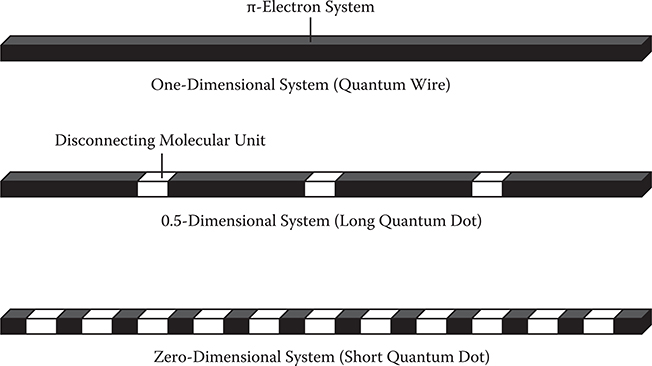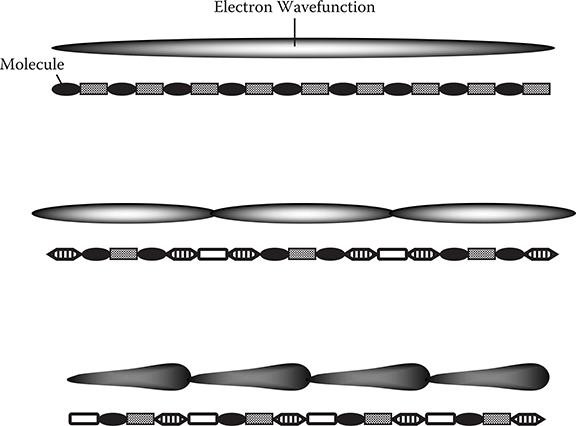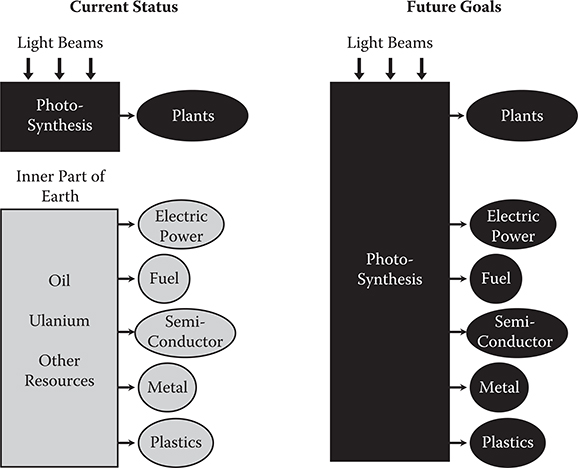1 Introduction
Organic functional thin-film materials are expected to be applied to various kinds of photonic/electronic devices, such as nonlinear optical circuits, photovoltaic devices, electroluminescent (EL) devices, thin-film transistors (TFTs), and bio/medical-photonic devices, due to the following four features.
Dimensionality, which affects optical and electronic properties, is easily controlled in organic thin-film materials, especially between the dimensionality of one and zero. The dimensionality control can be achieved in polymer wires as shown in Figure 1.1. Conjugated polymer wires are regarded as one-dimensional systems, that is, quantum wires, in which π-electrons are widely spread. By inserting molecular units that disconnect the spread of π-electrons, the dimensionality is reduced to somewhere between one and zero to make 0.5-dimensional systems, which correspond to long quantum dots. By increasing the density of the disconnecting molecular units in the polymer wires, lengths of the π-electron spread become shorter, creating zero-dimensional systems, which correspond to short quantum dots. Similar dimensionality control may also be achieved in molecular wires consisting of molecules connected to each other by electrostatic force.
Electron wavefunctions, which affect optical and electronic properties, are easily controlled in organic thin-film materials. The wavefunction shape control is achieved by placing constituent molecules in designated arrangements as to generate required properties. For example, as shown in Figure 1.2, widely spread wavefunctions, symmetric wavefunctions, and non-centrosymmetric wavefunctions can be formed in polymer wires or molecular wires by controlling the molecular sequences in the wires.
Carrier mobility is expected to be potentially very high in π-electron systems (Figure 1.3).
The resource problems will be resolved by using organic materials because they are mainly made of carbon (C), hydrogen (H), nitrogen (N), and oxygen (O), which exist in abundance on the surface of the Earth. At present, as shown in Figure 1.4, energy like electric power and fuel, and materials like semiconductors, metals, and plastics are mostly obtained from resources in the Earth’s interior. This destroys energy balance on the surface of the Earth and causes material shortages. In the future, in principle, organic materials for energy, semiconductors, metals, and plastics will be able to be synthesized from C, H, N, and O on the surface with the assistance of solar energy as illustrated in Figure 1.4.

FIGURE 1.1 The dimensionality control achieved in polymer wires.

FIGURE 1.2 Control of electron wavefunction shapes by placing constituent molecules in designated arrangements.
In order to realize high-performance thin-film photonic and electronic materials, control of dimensionality and wavefunction shapes by designated arrangements of molecules in the thin films is essential. Molecular layer deposition (MLD) is a promising method for doing this. In MLD, different kinds of molecules are introduced onto a substrate surface with designated sequences to achieve monomolecular step growth of polymer wires or molecular wires using the self-limiting effect.

FIGURE 1.3 π-electron transportation in a conjugated polymer wire.

FIGURE 1.4 Solution for the resource problems: organic material production by photosynthesis from C, H, N, and O.
Furthermore, with the assistance of seed cores, MLD enables self-organized growth of polymer/molecular wire networks with designated molecular sequences, locations, and orientations. Therefore, MLD has the potential to construct artificial organic thin films for various types of photonic/electronic devices like nonlinear optical devices, photovoltaic devices, EL devices, and TFTs, and for molecular nano systems consisting of molecular circuits in large-scale integrated circuits (LSIs). In these applications, π-conjugated systems play especially important roles due to their extended electron wavefunctions. Meanwhile, MLD in the liquid phase is expected to contribute to biomedical fields including selective attack on cancer cells.
In the present book, artificial thin-film photonic materials and devices (in which atomic and molecular arrangements are precisely controlled) and their fabrication methods are reviewed, especially emphasizing MLD. Their applications to optical interconnections within computers, optical switching systems, solar energy conversion systems, and biomedical photonics are discussed.
In Chapter 2, conventional atomic/molecular assembling techniques are shown, including scanning tunneling microscopy (STM), molecular beam epitaxy (MBE), plasma chemical vapor deposition (Plasma CVD), atomic layer deposition (ALD), sputtering, and vacuum deposition polymerization. As examples of the material property control achieved by the atomic arrangement control, direct observation and manipulation of electron wavefunctions, the high electron mobility transistors (HEMT), the multiple quantum well light modulators, photoconduction enhancement in a-Si:H/a-SiNx:H superlattices, and small polaron absorption enhancement in WOx electrochromic thin films are presented.
In Chapter 3, first, fundamentals of MLD-utilizing chemical reactions and electrostatic force are explained. Then, molecule-by-molecule growth of artificial polymer wires and molecular wires, and orientation-controlled growth from seed cores, which is necessary to construct high-performance photonic devices and polymer/molecular wire networks, are reviewed. Experimental demonstrations include the gas-phase MLD for polymer wires of polyimide and conjugated polymer wires of polyazomethine, and the liquid-phase MLD for molecular wires consisting of p-type and n-type dye molecules. In addition, the selective wire growth techniques, which can be used with MLD, are shown.
In Chapter 4, after fundamentals of quantum dots are explained, there is an experimental demonstration of multiple quantum dot (MQD) construction in polymer wires by arranging two kinds of molecules and by arranging three kinds of molecules using MLD. Observation of the quantum confinement of electrons in the MQDs confirms the prospects of the dimensionality control accomplished by MLD.
Chapter 5 begins with an explanation of the concept of the molecular orbital (MO) method and the concept of nonlinear optical phenomena such as the electro-optic (EO) effect. Then, predictions of EO effect enhancement, which was accomplished using the MO method, are presented. The EO effect is greatly enhanced by wavefunction control in conjugated polymer wires with MQDs that will be realized by MLD.
In Chapter 6, after several types of optical switches are shown, design and simulated switching characteristics are described for waveguide prism deflector (WPD) optical switches and nano-scale optical switches consisting of ring resonators. The impact of EO-conjugated polymers with MQDs on improvement of the optical switch performance is discussed.
In Chapter 7, various examples of organic/polymer photonic materials and devices, whose performance will be improved by utilizing MLD, are presented, including EO molecular crystals and polymers, EO waveguides and switches. As related material/device integration process technologies, nano-scale optical circuits, self-organized lightwave network (SOLNET), resource-saving heterogeneous integration, optical waveguide films with vertical mirrors, and 3-D optical circuits are also described.
Chapter 8 presents possible applications of the thin-film organic photonics to optoelectronic (OE) systems, such as optical interconnects within boxes and three-dimensional micro optical switching systems, are presented.
In Chapter 9, applications of the thin-film organic photonics to solar energy conversion systems are presented. Principle and experimental demonstrations are shown for multidye sensitization and polymer-MQD sensitization, which are realized by MLD. The chapter also discusses waveguide-type photovoltaic devices, low-cost integrated solar energy conversion systems, and flexible films.
Chapter 10 presents proposals for MLD applications to bio/medical-photonics, including photodynamic therapy for cancer to perform a three-dimensional selective attack on cancer cells by two-photon excitation with different wavelengths utilizing multimolecule stacks constructed by MLD, and a novel therapy in which SOLNET finds cancer cells and guides light beams to them.
